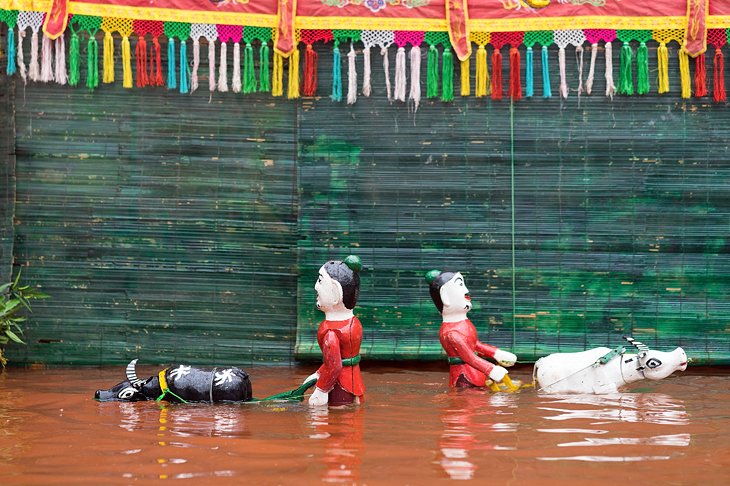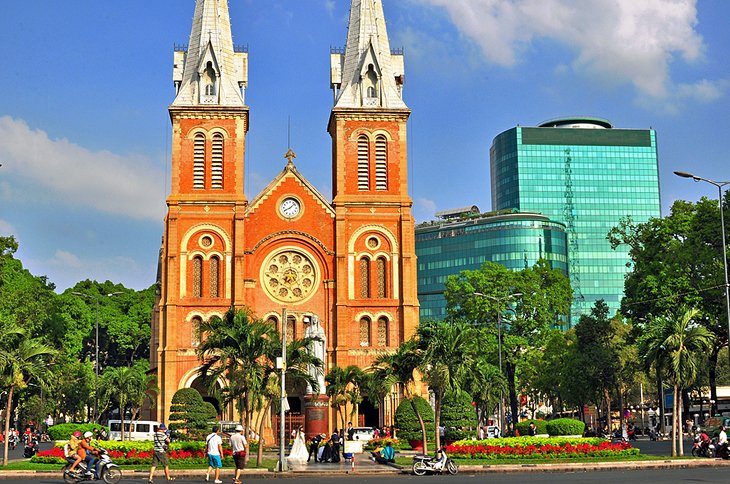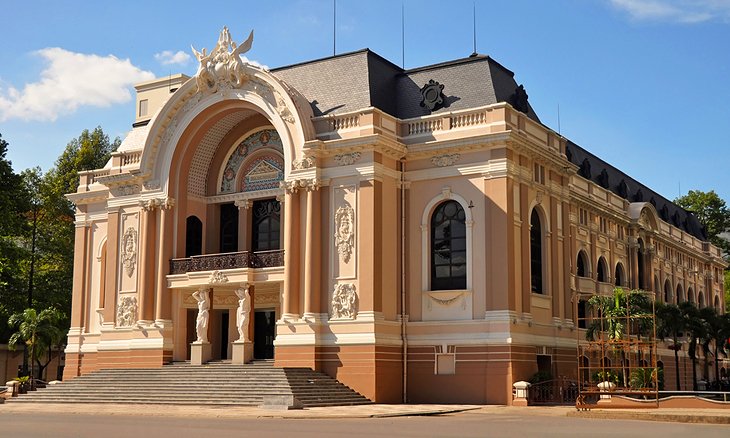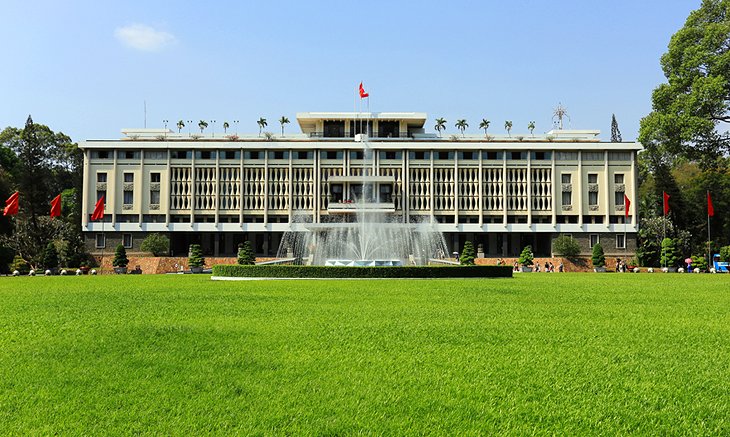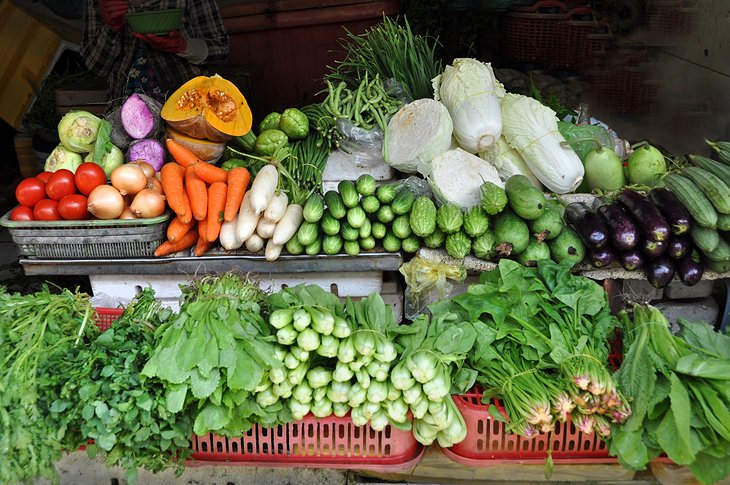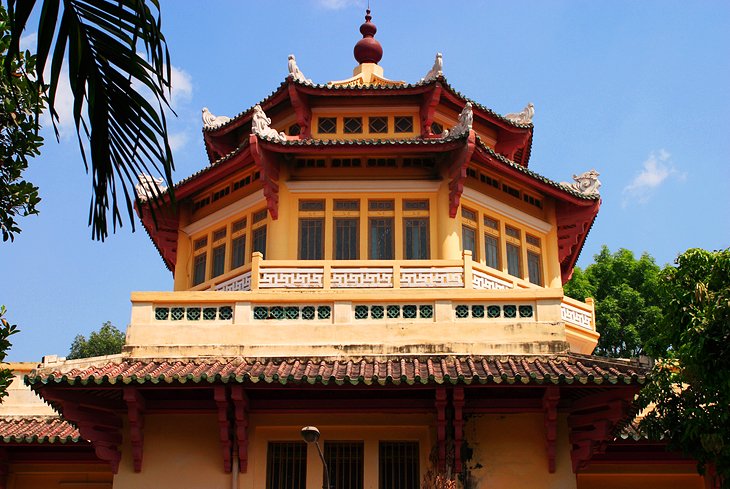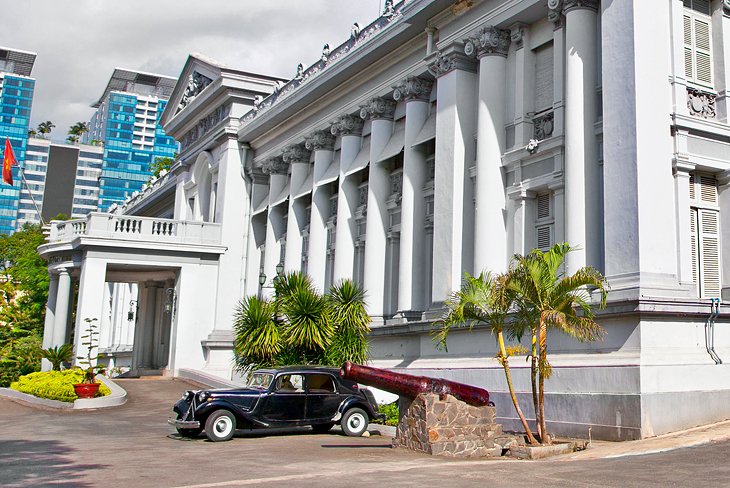Best Things to Do in Ho Chi Minh City
Still often referred to by it's old name, Saigon, Ho Chi Minh City is a clamorous, chaotic sensory feast. Motorbikes honk in a tidal wave across clogged intersections, locals crouch on street corners slurping steaming hot bowls of Pho (noodle soup); and the sultry air is thick with exhaust fumes and exotic spices.
Ho Chi Minh City is Vietnam's commercial hub and largest city, and it's a place where old abuts new with striking contrast. Temples huddle amid skyscrapers and designer shops, locals cast bamboo fishing rods into the languorous Saigon River, and in places, the city feels almost European, with its elegant French colonial architecture and wide, tree-lined avenues. Adding to the fascinating cultural jolt are a clutch of intriguing tourist attractions, from the poignant War Remnants Museum and captivating water puppet shows to colorful markets and the time warp of the Reunification Palace. Not far from the city, the famous Củ Chi tunnels are a must-see attraction, and the lush waterscapes and small villages of the Mekong Delta provide a fascinating glimpse of rural life.1 War Remnants Museum
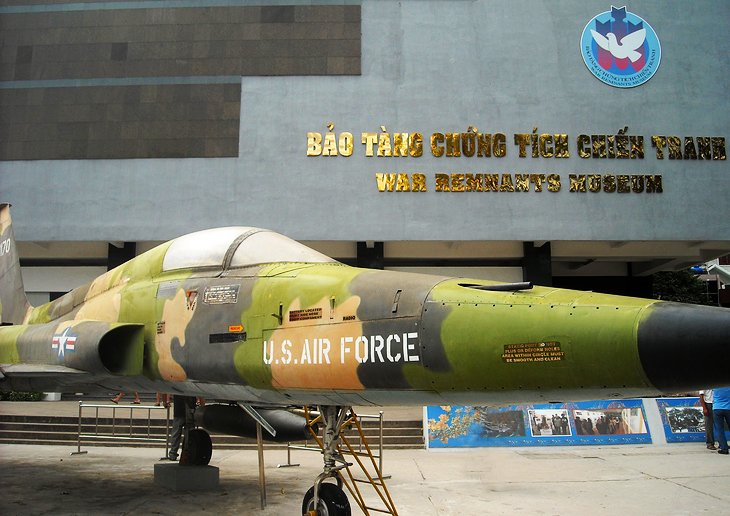
The War Remnants Museum is one of the most popular museums in Vietnam, with harrowing exhibits related to the horrors of war in this battle-worn nation. The museum primarily focuses on the Vietnam War, however some exhibits relate to the first Indochina War with French colonialists. It's a good idea to start on the top floor and work your way down, so you cap off your experience with the lighter exhibits on the ground floor. Most of the displays are photographic images, and some of these are confronting - especially the graphic shots of child Agent Orange victims. Artifacts on display include a guillotine and the "tiger cages" used for Viet Cong prisoners. Many argue that the museum's approach is biased, however the exhibits poignantly portray the brutality of war. The museum also includes a fascinating display on the work of war photographers, from both sides, who lost their lives during the conflicts. Period military vehicles and weapons are displayed in the museum's courtyard. After touring the countryside and the Củ Chi Tunnels, you'll find these exhibits even more moving, but note that some of the exhibits are not suitable for small children.
Address: 28 Vo Van Tan, Ward 6, District 3, HCMC
2 Golden Dragon Water Puppet Theatre
The Golden Dragon Water Puppet Theatre is perfect for families with young children and anyone who enjoys light-hearted traditional entertainment. Water puppetry originated in rural villages in the Red River Delta and has been performed in Vietnam for more than 1,000 years. The captivating 50-minute show provides a window into the country's culture. It's presented in Vietnamese, but the strength of the puppet characters, both people and animals, transcends the language barrier. Live music enhances the experience; the talented musicians play traditional instruments such as bamboo flutes and two-stringed violins. The theater is air-conditioned, and if you're sitting in the front row, be prepared for some gentle splashes.
Address: 55B Nguyen Thi Minh Khai Street, Ben Thanh Ward, District 1, Ho Chi Minh City
3 Thiên Hậu Temple, Chinatown
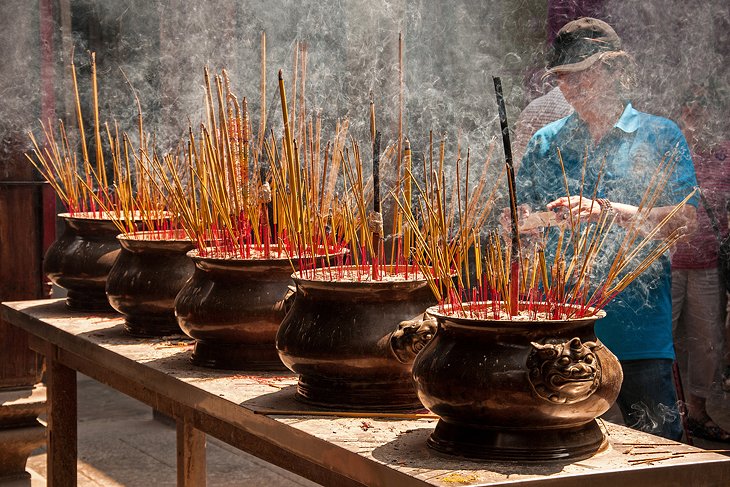
The atmospheric 19th-century Thiên Hậu Temple is one of the top sights in Ho Chi Minh City's Chinatown (ChoLon) and one of the oldest Chinese temples in the city. Dedicated to the Lady of the Sea, Thiên Hậu, this evocative temple is visited by local worshippers as well as tourists, and many of the materials used in its construction were brought from China. Clouds of incense billow in the air, candles flicker on altars, and shafts of sunlight pierce through the partial roof as you enter the green wrought-iron gates and stroll across the small courtyard. From here, you can see the altar, with statues of the goddess, and the intricate porcelain dioramas adorning the roof depicting scenes from 19th-century Chinese life. According to legend, the goddess left two turtles to guard the temple in her absence. On the 23rd day of the third lunar month, a parade takes place in the neighborhood featuring a figure of Thiên Hậu, who is believed to save seafarers stranded on the high seas. Entry to the temple is free.
While you're visiting China Town, it's also worth stopping by the hectic Binh Tay Market, which sells everything from fresh produce to Chinese trinkets. The area is also home to some beautiful examples of classical Chinese architecture.
Address: 710 Nguyen Trai Street, District 5, Ho Chi Minh City
4 Notre Dame Cathedral Basilica of Saigon and the Post Office
A fine example of Neo-Romanesque architecture, the red-brick Notre Dame Cathedral is a distinctive landmark in the heart of Ho Chi Minh City. Its twin square towers rise almost 60 meters above the city, capped by iron spires. Built from 1877 to around 1883, the cathedral was intended to be a place for the colonial missions to worship and a symbol of the power of the French colony. The exterior consists of red bricks from Marseille, and the clock between the two bell towers was built in Switzerland in 1887. Notable features of the interior include 56 squares of stained glass by Lorin from Chartres, France, the 12 pillars representing the 12 apostles, and one of Vietnam's oldest organs. To see the interior, try visiting in the morning or attending a Sunday mass.
Across the street, the French colonial-style post office, completed in 1891, was designed by Gustave Eiffel, the French architect of the Eiffel Tower. Today, the post office is still in use and is a popular meeting place for locals.
Address: Notre Dame Cathedral Basilica of Saigon, Bến Nghé, tp. Hồ Chí Minh, Ho Chi Minh;
5 Saigon Opera House
Also known as The Municipal Theatre of Ho Chi Minh City, the elegant Saigon Opera House, at the start of the famous tree-lined Le Loi Avenue, is eye-candy for architecture buffs - especially fans of the French colonial style. It was built as Opėra de Saigon in 1897 by Eugene Ferret, a French architect, to entertain French colonists, and its striking facade echoes the style of the Petit Palais, which was built in the same year in Paris. After 1956, the building was used as the home of the Lower House assembly of South Vietnam and again became a theater in 1975, after the fall of Saigon. The only way to see the theater's interior is to purchase a ticket to a show. Both the Ho Chi Minh City Ballet Symphony Orchestra and Opera perform here, and tickets are available at the box office or local travel agents. In the area around the opera house are some of the city's new shopping malls and exclusive hotels. You can also combine a visit here with the nearby Notre Dame Cathedral and Reunification Palace.
Address: 7 Lam Son Square, Ben Nghe Ward, District 1, Ho Chi Minh City
6 Reunification Palace
A visit to the Reunification Palace, once known as Independence Palace, is more about the historic events that took place here than any pomp and grandeur. In fact, this 1960s-style building, with its large, airy rooms and dated furnishings, seems frozen in time since April 30, 1975, when a North Vietnamese army tank crashed through the iron gates here, bringing an end to the Vietnam War. For locals, the palace represents this historic event and and the reunification of the country.
Set on 44 acres of lush lawns and gardens, the palace also offers a fascinating glimpse at the lifestyle of privileged heads of state in 1960s Saigon. It was built on the site of the former Norodom Palace, which was bombed by fighter jets in 1962 in an unsuccessful assassination attempt on the South Vietnamese president Ngo Dinh Diem. The current building was completed in 1966 and became the home and workplace of the successive president when Vietnam was split between the north and the south. Notable features include the president's living quarters, the war command room with large maps and antiquated communications equipment, and the maze of basement tunnels. You'll also see military vehicles outside, including the fighter jet that destroyed the Norodom Palace and tank 843, which rammed through the palace gate on that fateful day in April more than four decades ago. Guided tours in English are available.
Address: 135 Nam Ky Khoi Nghia Street, District 1, Ho Chi Minh City
7 Ben Thanh Market & Saigon Square
For sightseers, the hot and hectic Ben Thanh Market is almost an obligatory stop, even if only to witness the crammed stalls and market chaos. The stalls are piled high with everything from local delicacies, fish, flowers, and tropical fruits to shoes, clothes, colorful candy, and souvenirs. The markets are also notorious for pickpockets, so make sure any valuables are secure and out of sight. After soaking up all the ambiance, head to Saigon Square, about a three-minute stroll away, for a slightly less frenetic shopping experience with the added bonus of air conditioning. Here, you'll find fantastic deals on everything from clothing and backpacks to jewelry and shoes. Haggling is customary at both locations.
Ben Thanh Market
Address: 32-30, 36-34-32-30 Phan Bội Châu, Bến Thành, Hồ Chí Minh City
8 Museum of Vietnamese History
Within the grounds of the botanic gardens, the Museum of Vietnamese History unveils the country's cultural evolution from the Bronze Age to the early 20th century. The exhibits are organized chronologically and include artifacts from Vietnam's former ethnic groups, including the Dong Son, Funan, Khmer, and Cham civilizations. Particularly interesting are the stone and bronze sculptures, Angkor Wat relics, and the well-preserved mummy. For an extra fee, you can attend a water puppet show in the museum's small theater, with performances held every hour (except during lunch). Almost as interesting as the museum exhibits is the building itself, which dates from 1929 and fuses French and Asian architectural styles. After viewing all the museum exhibits for an hour or so, you can enjoy a relaxing stroll around the botanic gardens.
Address: 2 Nguyễn Bỉnh Khiêm, Bến Nghé Hồ Chí Minh City
9 Jade Emperor Pagoda
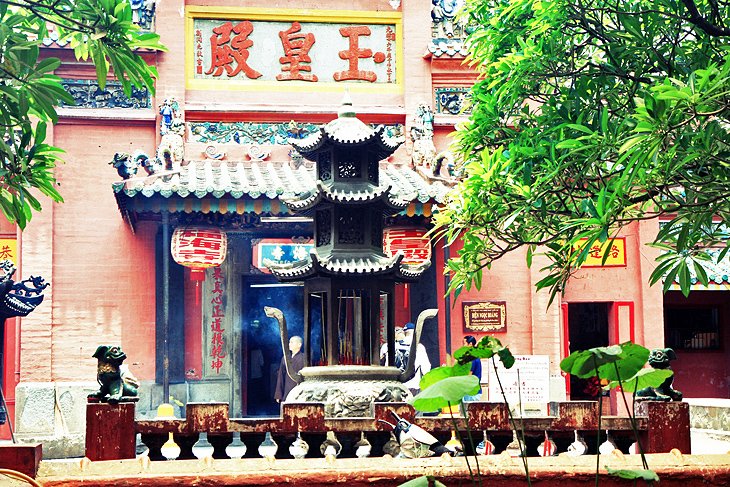
Built in the early 20th century, the evocative Jade Emperor Pagoda (Chua Phuoc Hai) sits in an unassuming neighborhood a few blocks away from the Botanical Gardens. The temple was built in honor of the Taoist god, the Jade Emperor or King of Heaven, Ngoc Hoang, and within its dimly lit interior you'll see many representations of both Buddhist and Taoist deities. As you step inside, incense shrouds the many local worshippers, and candles illuminate altars brimming with offerings. Of special note are the intricately carved panels of woodwork and the many elaborate dragon and animal sculptures adorning the roof. At the temple's entrance, masses of turtles swim in a pond, some with inscriptions on their shells, and for this reason, the temple is often called the tortoise pagoda. Locals come here frequently to worship, so it's important to be respectful when you visit.
Address: Đa Kao Quận 1 Vietnam, 73 Mai Thị Lựu, Đa Kao, Hồ Chí Minh
10 Ho Chi Minh City Museum
Near the Reunification Palace, the Ho Chi Minh City Museum occupies an impressive Neoclassical building, formerly known as Gia Long Palace, that was once home to the Cochinchina's governor. It's worth a stop for an overview of the city's history and a gawk at the grand architecture, which includes Oriental and European flourishes. The museum traces the city's past with exhibits on the struggle for independence, nature and archaeology, trade, village handicrafts, currency, and the culture of Saigon. Interestingly, the building sits on a network of tunnels and bunkers, which served as escape routes for past dignitaries, though these are closed to the public.
Address: 65 Ly Tu Trong, District 1, Ho Chi Minh City
11 FITO Museum
Although it's a little challenging to find if you're traveling without a guide, the first Museum of Traditional Vietnamese Medicine (FITO) occupies a beautiful old five-story building framed by bamboo. It's worth a look for anyone who is interested in alternative medicine or wants to soak up some Vietnamese culture away from the main tourist trail. The museum displays thousands of items relating to Vietnamese traditional medicine, from the Stone Age to the present day, including books, documents, herbs, and implements used in preparing the medicines. You can also try your hand at grinding up some of the ingredients. The presentation begins with a short film on the history of Vietnam's traditional medicine, and herbal cures are available for purchase before you leave.

